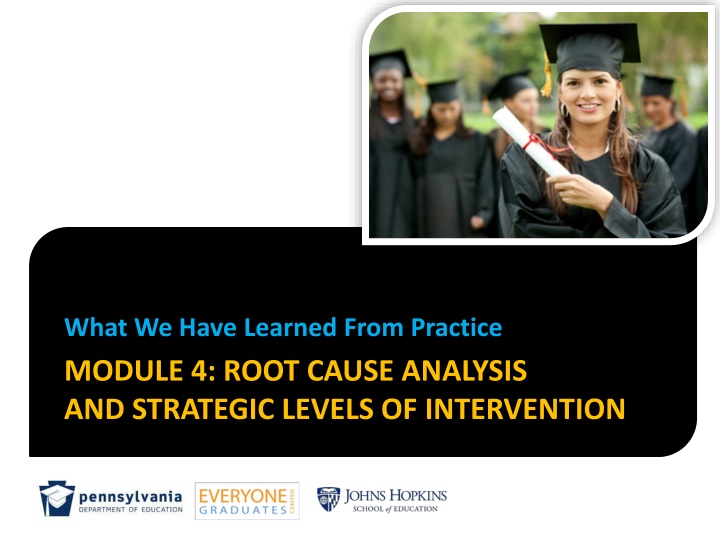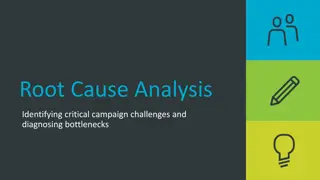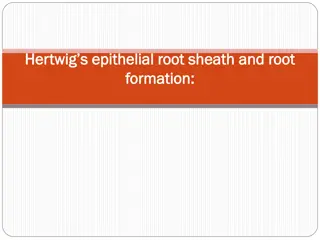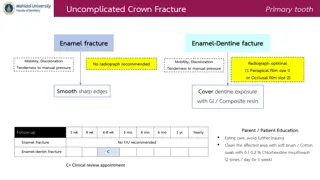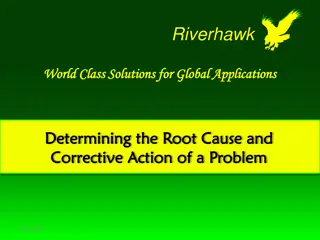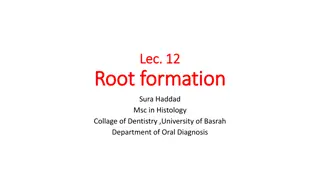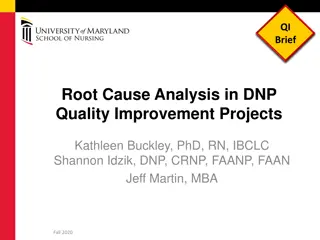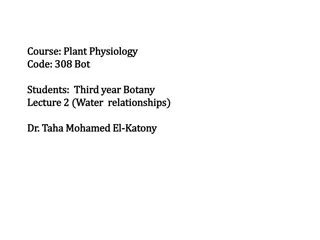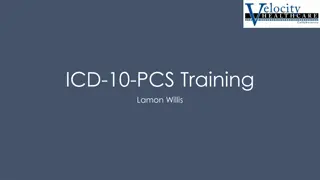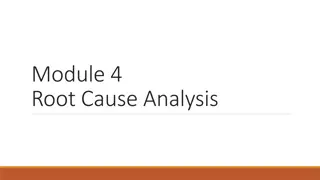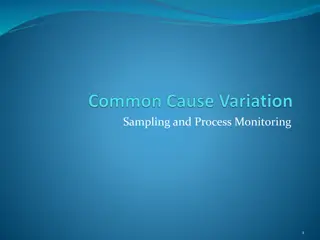MODULE 4: ROOT CAUSE ANALYSIS AND STRATEGIC LEVELS OF INTERVENTION
Root Cause Analysis explores underlying factors impacting student outcomes to facilitate better responses. This module delves into strategic intervention levels for diagnosing patterns and identifying improvement steps for individuals and groups within educational settings. External factors, risks, early adolescence challenges, and brain science insights are discussed for a comprehensive understanding.
Download Presentation

Please find below an Image/Link to download the presentation.
The content on the website is provided AS IS for your information and personal use only. It may not be sold, licensed, or shared on other websites without obtaining consent from the author.If you encounter any issues during the download, it is possible that the publisher has removed the file from their server.
You are allowed to download the files provided on this website for personal or commercial use, subject to the condition that they are used lawfully. All files are the property of their respective owners.
The content on the website is provided AS IS for your information and personal use only. It may not be sold, licensed, or shared on other websites without obtaining consent from the author.
E N D
Presentation Transcript
What We Have Learned From Practice MODULE 4: ROOT CAUSE ANALYSIS AND STRATEGIC LEVELS OF INTERVENTION
Outcomes of Module 4 Adults will have deepened understanding of root cause analysis and its applications in their school and district. Adults will practice using strategic levels of intervention to: Diagnose individual and group patterns regarding dropping out and staying on track. Identify next steps for individual, group and whole school improvement.
Introduction: What is Root Cause Analysis ? Root cause analysis: How one determines what underlying factors lead to student outcomes in order to provide better results. In EWS, this helps us understand some of the situations which offer challenges for students so that we can look for better areas of response.
Root Cause Analysis Background Causes Framework Causes Health issues Impact of low socio- economic status Family issues Transition to 9thgrade Relationships Adult actions Policies that push students away Policies that impact one group over another
BACKGROUND: THE IMPACT OF EXTERNAL FACTORS
External Risk Factors Impact Academic and Social Behaviors Exposure to Violence Residential In-Stability Hunger and Poor Family Health Students as Caregivers Kids who grow up in stressful environments find it harder to concentrate, follow directions, and rebound from disappointment. This has a direct effect on their school performance.
Early Adolescence Brings its Own Set of Challenges For Students? Flight, fight and withdrawal Some students stop attending school regularly. Flight Some students start acting out and being disruptive in class. Fight Some students just stop trying and start failing courses. Withdrawal
The Good News in Recent Lessons from Brain Science There is substantial plasticity to the human brain: it can be shaped and re-shaped through life experiences. Important brain developments continue through young adulthood, in particular around self-regulation. Student relationships with caring and supportive adults are powerful antidotes to the stress impacts of socio-economic disadvantaged backgrounds. Schools can be organized to enable students to overcome many of the impacts of being socio-economic disadvantaged.
FRAMEWORK: THE IMPACT OF POLICIES AND STRUCTURES
Responses to Environments Influence Leaving School: Listening to Early Dropouts (10th graders) Boys Girls Didn t like school 58% 44% Didn t get along with teachers 52% 17% Felt didn t belong at school 31% 14% Couldn t get along with peers 18% 22% Suspended too often 19% 13% Failing school 46% 33% Couldn t keep up with work 38% 25% . Source of table is NELS:88. Two Years Later, National Center for Education Statistics (NCES)
Stress: Transitions Are Difficult - Attendance Worsens as Students Move from Grade 8 to 9 Number of days missed in the first 30 days of school, by the same students, first in 8th and one year later in 9th grade, for first-time freshmen in neighborhood high schools 100 0-4 days 5-9 days 10+ days 80 60 % 40 20 0 n=7643 98-99 99-00 School year
Stress: Transitions are Difficult -- Percent Passing Core Courses Drops as Students Move from Grade 8 to 9 100% 80% 60% 40% 8th grade 9th grade 20% 0% High schools n=7085
Same Patterns, Different Numbers The following three slides are included to illustrate the fact that while different districts often educate different sub-groups of students or may educate similar students differently, or may have different policies and practices that influence how students are treated there are similar patterns in outcomes although the absolute numbers and percentages vary. Note the patterns for the different indicators. Reflect on what you might see if you compared your district with others in the state. (This data is derived from a study of five Colorado districts).
Attendance % of dropouts chronically absent in year prior to dropout % of graduates chronically absent in year prior to graduation 78% 69% 63% 61% 39% 35% 31% 24% 19% 6% District 1 District 2 District 3 District 4 District 5 14
Achievement Differences There are over 50 million school children in America today, only 81 percent of whom on average, graduate from high school, with far fewer well-prepared for college. There are vast differences in high school graduation rates among states with state graduation rates ranging from 69 percent to 90 percent (2012-2013). For African American students, Hispanic students, students with disabilities, and low-income students graduation rates are on average 10 to 20 percentage points lower than those for white and Asian students, and also surprisingly variable by state. There are achievement gaps that are just as variable by state.
Do Students Vary Much by State? The percent of students identified as in need of special services for students with disabilities ranges from 9 to nearly 18 percent by state. Do students really vary that much? High school graduation rates, by state, for students with disabilities, range from the mid- 20 s to the high 70 s. Do students really vary that much?
Why Does Students Performance Vary So Much by State? The differences between subgroups vary greatly by state. In some states there is almost no difference, in others, there are up to 40 percentage point differences. Is it that the students differ so much or that adult policies and practices vary? Check out Building a Grad Nation: Annual Report 2014, and the soon to be published Building a Grad Nation: Annual Report 2015. Read the tables and reflect on the differences among students in different states.
An Example -- Discipline Disparities In Georgia, males make up 2/3 of the population subject to OSS (out-of-school-suspension). African-American students are three times as likely to receive OSS as others. Students eligible for free- or reduced-price lunch are twice as likely to receive OSS, and special education students, 1.5 times as likely. There are multiple discipline designations in Georgia through state code; multiple interpretations of policy and implementations in practice are possible at the local level. Georgia is a local control state and teachers and administrators are strongly supported in local interpretations of state code.
More About Discipline Disparities Georgia s results are not unique. The US Department of Education s Office of Civil Rights reports that across the country, black students are disciplined at far higher rates than white or Asian students, especially for minor discipline infractions for which teachers and administrators have discretion. In some states the same is true for Hispanic students. Multiple state studies show this as well Texas, Virginia and Florida, to name a few.
Student Voice When students talk with adults who listen, individually, in focus groups, and through the media, when students write for others, and when they are surveyed, they share many startling observations about subjects as varied as instruction, school climate and adult interactions with students in school and out. Check out the EGC/PDE website under resources for suggested reading and see the next slide.
Student Voice A good way to find out what students think would be helpful to improve the ABC s in your school is to: Do a paper-and-pencil survey or use Survey Monkey (if you have a nearby university or interested business partners, work with them.) Set up focus groups. Reflect on what is learned from student conferences. Establish faculty discussion groups around these topics.
Student Voice In the video clip that follows, we hear directly from a middle school student interviewed by PBS Frontline regarding her experiences, needs, goals and dreams. Watch it and discuss it with your colleagues. Check out other PBS/CPB video clips on this and related subjects. Video clips can be used to inspire discussion among adults, but also with students, and parents.
Root Cause Analysis Attendance Behavior (referrals) Course Performance Student 13-14 year Sept 13-14 year Sept Math Q4 Math Sept. ELA Q4 ELA Sept 0, 10 Tardy #Samuel 99% 14 2 B 82% D 55% Background auses Framework causes Health issues Impact of being socio- economic disadvantaged Family issues Transition to 9th grade Relationships Adult actions Policies that push students away Policies that impact one group over another
STRATEGIC LEVELS OF INTERVENTION
Overview Strategic Level of Intervention 1. Provide Intensive efforts involving specialists (counselors, social workers, teachers) for the 5% to 10% of the students who don t respond to other supports. 2. Target interventions for those who develop an indicator despite school-wide prevention efforts. 3. Provide school-wide programs aimed at preventing 75% of the students from developing any of the ABC indicators.
Finding the Most Strategic Level 2) Determine number and percentage of students in need of support school wide and by grade level for each challenge. 1) Decide what are your schools biggest challenge -- Attendance? -- Behavior? -- Course-Passing? 3) Which challenges can be addressed by school wide, grade- level or group campaigns or efforts? 4) Determine how many students can feasibly be supported by the EWS team, when a whole school or small group intervention is not sufficient; then decide how many other additional adults you will need to bring into the EWS process. 5) If needed, add to the existing responsibilities of leadership, RTI, interdisciplinary/ grade level teams, or create new ones
The ABC Challenge Activity: Intervention Process Map The School s Critical ABC Challenge: Where is the first level of intervention? Is there a second level for small groups? What is intervention if whole school plus small group is not working?
Solving ABC Challenges at Most Strategic Level Why are some courses failed more often than others? Look for underlying causes that could be addressed across students. PE may be the cause of many students failure because they don t like to dress out, the gym is far from their other class locations, or they perceive that bullying takes place. Math may be failed by many because they don t have the pre-requisite background. A particular teacher may have unreasonable expectations, not know how to manage a classroom, fail to give enough grades or fail to report grades in a timely fashion.
Solving ABC Challenges at Most Strategic Level Reasons students indicated why they weren t passing their current courses
Finding the Most Strategic Level of Intervention Attendance examples: Strong attendance at the beginning of the semester and then starts dropping. About 30 students have really serious attendance problems. Potential Responses: An overall school attendance plan A school-wide or grade-level attendance campaign is initiated. Incentives for the most improved are awarded and publicized.
Most Strategic Interventions: Whole School Research shows that development of executive function, self- and time- management skills are critical elements for 6th to 9th graders undergoing the transition from childhood to young adulthood and many times are lacking for students.
Teaching Student Skills at Whole School or Grade Wide Levels Existing or new setting for teaching these skills: Advisory or dedicated course Skills taught as a part of each content s lesson plan Initiatives: Grade level assemblies for review Recognition events for students School-wide expectations for each area of the skills
Teaching Student Skills --Embed in summer orientation -- Hold a half-year course -- Introduce skills (with a curriculum) in an advisor/advisee period --Teach the skills in regular academic courses, with common approaches developed by the faculty The majority of 9th graders lack study, time and self- management skills -- Have alums and seniors talk with freshmen -- Bring in speakers from local businesses and other respected members of the community -- Show short videos from YouTube -- Arrange job-shadows Require use of skills daily with donated incentives Obtain planners from local businesses Practice keeping a calendar on cell phones
Small Group Approaches Aimed at common behaviors or challenges Potentially more efficient use of staff time
Small Group Approaches for Behavior Are there students in your school who share very specific behavioral challenges (about-to- be or young mothers, foster and homeless children, children with anger management problems)? Is there someone on staff who has the expertise and time to convene a weekly small group meeting for these students, or could external community assistance be utilized?
Activity: Solving a Scenario Working individually, with a colleague or with your team, consider the scenarios. Pick a scenario (one is of an individual student, one is of an emerging group pattern, one is of a school-wide challenge, and one is of a district-wide challenge). What is going on? What resources can be brought to bear to solve this challenge? Who can help?
